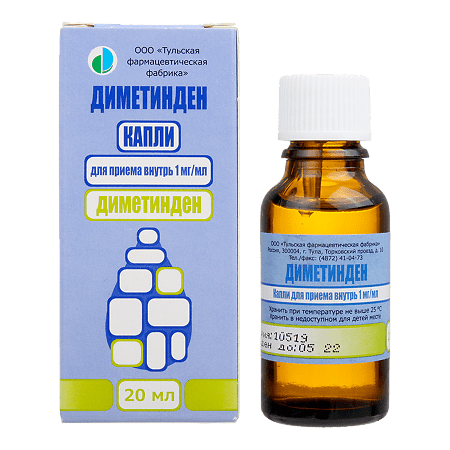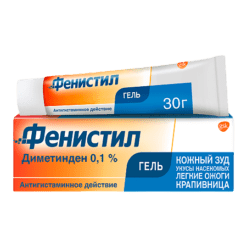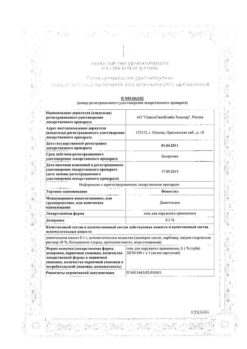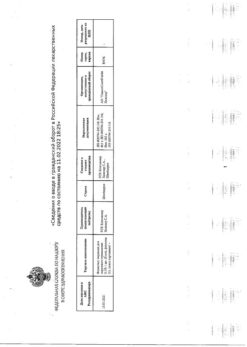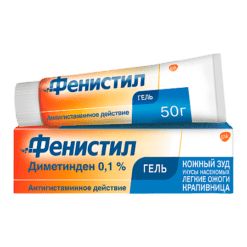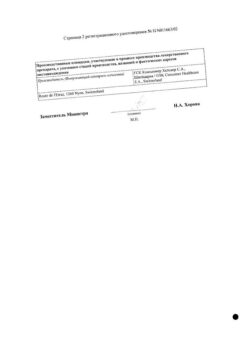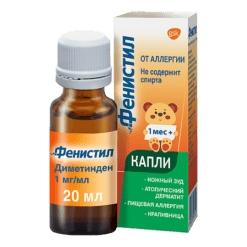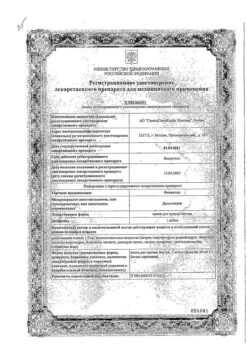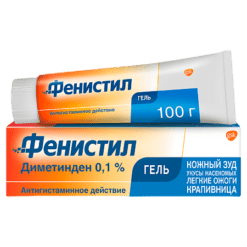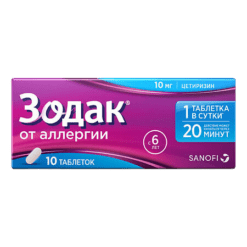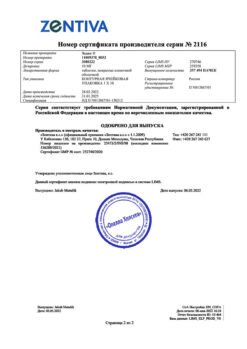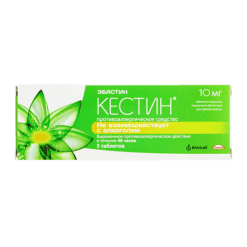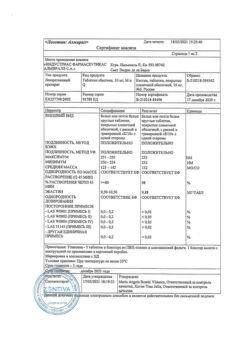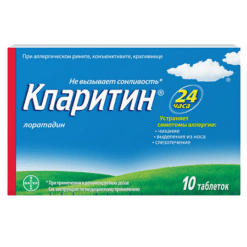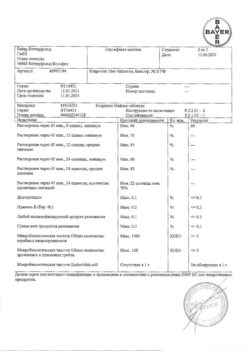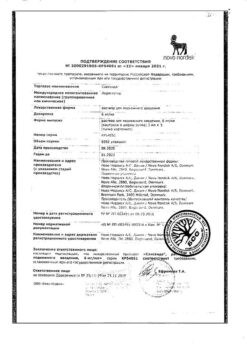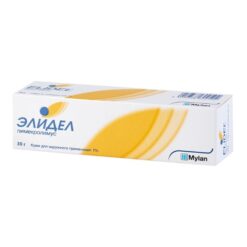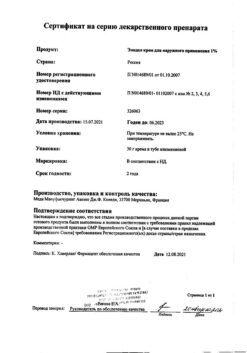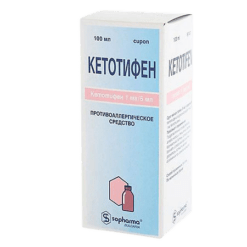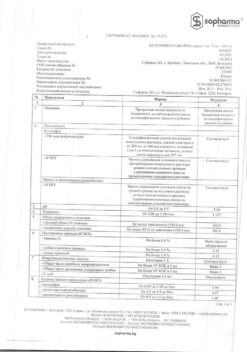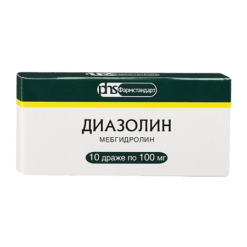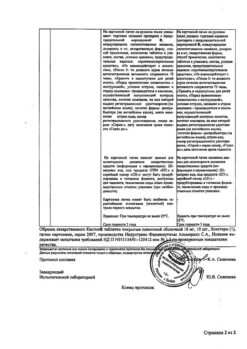No products in the cart.
Description
An antihistamine, anti-allergic and antipruritic agent. Blocker of H1-histamine receptors, is a competitive histamine antagonist.
The drug reduces increased capillary permeability associated with allergic reactions.
It also has anti-bradykinin and weak m-cholin-blocking effects. A mild sedative effect may be noted when the drug is taken during the day.
< section>Pharmacokinetics:
It is rapidly and quite completely absorbed when taken orally. Bioavailability is about 70%. Antihistamine effect begins to appear 30 min after oral administration, reaching maximum intensity after 5 h. Time of reaching maximum concentration of dimethinden in blood plasma after oral administration is 2 hours. Binding with plasma proteins is 90%. It penetrates well into the tissues.
Metabolized in the liver by hydroxylation and methoxylation. Half-life is 6 hours. It is excreted with bile and urine (90% as metabolite and 10% unchanged).
.
Indications
Indications
Allergic diseases: urticaria, hay fever, year-round allergic rhinitis, angioedema; food and drug allergies.
Skin itching of various origins (eczema, itchy dermatoses: including atopic dermatitis; measles, rubella, chicken pox, insect bites).
Prevention of allergic reactions during hyposensitizing therapy.
Pharmacological effect
Pharmacological effect
Antihistamine, antiallergic and antipruritic agent. H1-histamine receptor blocker, is a competitive histamine antagonist.
The drug reduces increased capillary permeability associated with allergic reactions.
It also has an antibradykinin and weak m-anticholinergic effect. When taking the drug during the day, a slight sedative effect may be observed.
Pharmacokinetics:
It is quickly and completely absorbed when taken orally. Bioavailability is about 70%. The antihistamine effect begins to appear 30 minutes after oral administration, reaching its maximum severity after 5 hours. The time to reach the maximum concentration of dimethindene in the blood plasma after oral administration is 2 hours. Communication with plasma proteins – 90%. Penetrates well into tissues.
Metabolized in the liver by hydroxylation and methoxylation. The half-life is 6 hours. Excreted in bile and urine (90% as a metabolite and 10% unchanged).
Special instructions
Special instructions
In young children, in particular under 6 years of age, antihistamines can cause increased excitability.
The drug should not be exposed to high temperatures; When administered to infants, they should be added to a bottle of warm baby food immediately before feeding. If the child is already being spoon-fed, the drops can be given undiluted. The drops have a pleasant taste.
Do not exceed the recommended dose.
Ineffective for itching associated with cholestasis.
Impact on the ability to drive vehicles. Wed and fur.:
Like other antihistamines, dimethindene may impair alertness, so it should be used with caution when driving, operating machinery, or doing other work that requires increased alertness.
Active ingredient
Active ingredient
Dimetinden
Composition
Composition
For 1 ml:
Active ingredient:
Dimetindene maleate – 1.0 mg.
Excipients:
sodium hydrogen phosphate dodecahydrate – 16.0 mg,
citric acid monohydrate – 5.0 mg,
benzoic acid – 1.0 mg,
disodium edetate – 1.0 mg,
sodium saccharinate – 0.5 mg,
propylene glycol – 100.0 mg,
purified water – up to 1 ml.
Pregnancy
Pregnancy
The use of the drug during pregnancy (II-III trimester) is possible under the supervision of a physician, only if the expected benefit to the mother outweighs the potential risk to the fetus.
The use of the drug during breastfeeding is contraindicated.
Contraindications
Contraindications
Hypersensitivity to dimethindene and other components of the drug included in the drug, angle-closure glaucoma, bronchial asthma, prostate hyperplasia, children under 1 month of age, pregnancy first trimester, breastfeeding period.
With caution:
For chronic obstructive pulmonary diseases, epilepsy.
In children aged 1 month to 1 year, since sedation may be accompanied by episodes of sleep apnea.
Side Effects
Side Effects
The frequency of adverse reactions that may occur during therapy is given in the following gradation: very often (≥ 3/10); often (≥ 1/100 to < 1/10); uncommon (≥ 1/1000 to < 1/100); rare (≥ 1/10000 to < 1/1000); very rare (< 1/10000), including isolated reports and reactions with unknown frequency.
Immune system disorders:
Very rare: anaphylactoid reactions including facial swelling, pharyngeal swelling, rash, muscle spasms and shortness of breath.
Mental disorders:
Rarely: restlessness.
Nervous system disorders:
Very common: fatigue;
Often: drowsiness, nervousness;
Rarely: headache, dizziness.
Gastrointestinal disorders:
Rarely: gastrointestinal disorders, nausea, dry mouth, dry larynx.
If any of the side effects indicated in the instructions get worse or you notice any other side effects not listed in the instructions, tell your doctor.
Interaction
Interaction
Enhances the effect of anxiolytics, hypnotics and other drugs that depress the function of the central nervous system (opioid analgesics, anticonvulsants, tricyclic antidepressants, MAO inhibitors, antihistamines, antiemetics, antipsychotics, scopolamine, ethanol).
Tricyclic antidepressants and anticholinergic drugs (bronchodilators, gastrointestinal antispasmodics, etc.) increase the risk of increased intraocular pressure or urinary retention.
It is also necessary to avoid the combined use of antihistamines and procarbazine.
Overdose
Overdose
Symptoms: depression of the central nervous system (CNS) and drowsiness (mainly in adults), stimulation of the central nervous system and m-anticholinergic effects (especially in children), incl. agitation, ataxia, tachycardia, hallucinations, tonic-clonic convulsions, mydriasis, dry mouth, flushing, urinary retention and fever; decreased blood pressure, collapse.
Treatment: activated charcoal, saline laxatives, drugs to support the functioning of the cardiovascular and respiratory systems (analeptic drugs should not be used).
Storage conditions
Storage conditions
At a temperature not exceeding 25 °C.
Keep out of the reach of children.
Shelf life
Shelf life
3 years.
Manufacturer
Manufacturer
Tula pharmaceutical factory, Russia
Additional information
| Shelf life | 3 years. |
|---|---|
| Conditions of storage | At a temperature not exceeding 25 ° C. Store out of the reach of children. |
| Manufacturer | Tula Pharmaceutical Factory, Russia |
| Medication form | oral drops |
| Brand | Tula Pharmaceutical Factory |
Other forms…
Related products
Buy Dimethinden, drops 1 mg/ml 20 ml with delivery to USA, UK, Europe and over 120 other countries.

